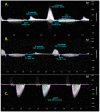Functional Assessment of Cardiac Responses of Adult Zebrafish (Danio rerio) to Acute and Chronic Temperature Change Using High-Resolution Echocardiography
- PMID: 26730947
- PMCID: PMC4701665
- DOI: 10.1371/journal.pone.0145163
Functional Assessment of Cardiac Responses of Adult Zebrafish (Danio rerio) to Acute and Chronic Temperature Change Using High-Resolution Echocardiography
Erratum in
-
Correction: Functional Assessment of Cardiac Responses of Adult Zebrafish (Danio rerio) to Acute and Chronic Temperature Change Using High-Resolution Echocardiography.PLoS One. 2016 Feb 12;11(2):e0149741. doi: 10.1371/journal.pone.0149741. eCollection 2016. PLoS One. 2016. PMID: 26871931 Free PMC article. No abstract available.
Abstract
The zebrafish (Danio rerio) is an important organism as a model for understanding vertebrate cardiovascular development. However, little is known about adult ZF cardiac function and how contractile function changes to cope with fluctuations in ambient temperature. The goals of this study were to: 1) determine if high resolution echocardiography (HRE) in the presence of reduced cardiodepressant anesthetics could be used to accurately investigate the structural and functional properties of the ZF heart and 2) if the effect of ambient temperature changes both acutely and chronically could be determined non-invasively using HRE in vivo. Heart rate (HR) appears to be the critical factor in modifying cardiac output (CO) with ambient temperature fluctuation as it increases from 78 ± 5.9 bpm at 18°C to 162 ± 9.7 bpm at 28°C regardless of acclimation state (cold acclimated CA- 18°C; warm acclimated WA- 28°C). Stroke volume (SV) is highest when the ambient temperature matches the acclimation temperature, though this difference did not constitute a significant effect (CA 1.17 ± 0.15 μL at 18°C vs 1.06 ± 0.14 μl at 28°C; WA 1.10 ± 0.13 μL at 18°C vs 1.12 ± 0.12 μl at 28°C). The isovolumetric contraction time (IVCT) was significantly shorter in CA fish at 18°C. The CA group showed improved systolic function at 18°C in comparison to the WA group with significant increases in both ejection fraction and fractional shortening and decreases in IVCT. The decreased early peak (E) velocity and early peak velocity / atrial peak velocity (E/A) ratio in the CA group are likely associated with increased reliance on atrial contraction for ventricular filling.
Conflict of interest statement
Figures





References
-
- Gollock MJ, Currie S, Petersen LH, Gamperl AK (2006) Cardiovascular and haematological responses of Atlantic cod (Gadus morhua) to acute temperature increase. J Exp Biol 209: 2961–2970. - PubMed
-
- Paajanen V, Vornanen M (2004) Regulation of action potential duration under acute heat stress by I(K,ATP) and I(K1) in fish cardiac myocytes. Am J Physiol Regul Integr Comp Physiol 286: R405–415. - PubMed
Publication types
MeSH terms
Substances
LinkOut - more resources
Full Text Sources
Other Literature Sources

